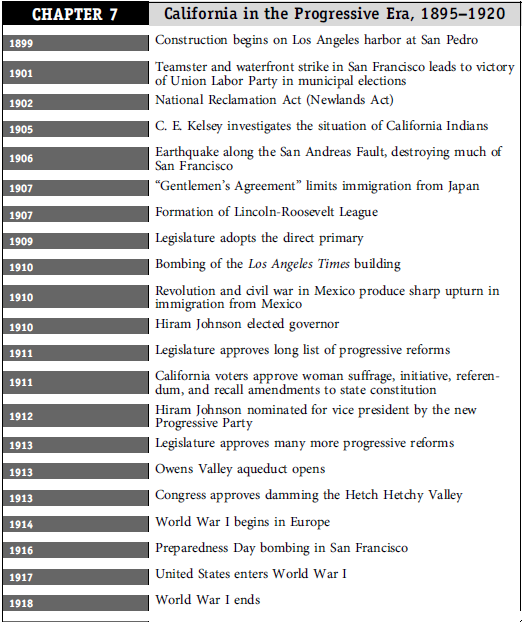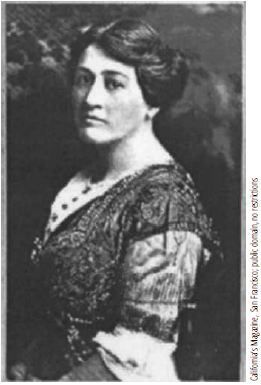7: California in the Progressive Era, 1895–1920
( \newcommand{\kernel}{\mathrm{null}\,}\)
Main Topics
- The Origins of California Progressivism
- Social and Economic Change in the Progressive Era
- California Progressivism, 1910–1920
- Californians in a World of Revolutions and War
- The Meaning of Progressivism for Californians
- Summary
Katherine Philips Edson and her husband Charles moved to Los Angeles in 1899. Kate, as her friends and family called her, then joined the Friday Morning Club, one of the most prestigious women’s clubs in southern California, where she was soon centrally involved in that club’s evolution into a proponent for reform. Her first major foray into politics was a campaign to improve the regulation and inspection of dairies, to guarantee that children’s milk would come from healthy cows and be free of contaminants. She quickly became the most prominent woman in state politics.
Philips Edson helped to organize support for Hiram Johnson’s successful campaign for governor in 1910, then became the chief lobbyist for woman suffrage during the 1911 legislative session. Carefully watching the final vote, she clapped her hands gleefully when the assembly voted to put the issue before the voters. She then headed up the

southern California campaign for approval of the woman suffrage amendment. In 1912, she became a member of the Progressive Party State Central Committee, supporting the third-party presidential campaign of Theodore Roosevelt and Hiram Johnson.
Also in 1912, Johnson appointed her as a deputy inspector in the State Bureau of Labor Statistics. In that capacity, she conducted studies that persuaded the legislature in 1913 to regulate women’s working conditions. Johnson then appointed her to the new Industrial Welfare Commission (IWC), responsible for implementing and enforcing the new

Katherine Philips Edson, seen here in a formally posed photograph, was the most prominent woman in California progressivism. A moving force behind passage of a minimum wage law for women in 1913, she was appointed by Hiram Johnson to the new Industrial Welfare Commission and served eighteen years. She also became chief of the Division of Industrial Welfare in 1927. How does her career reflect new patterns of women's involvement in politics during the progressive era?
regulations. She served on the IWC until 1931 and was the chief administrator for much of that time. During World War I, she served on the State Council of Defense and as federal Industrial Mediator for California. A strong advocate for approval of the Nineteenth Amendment (woman suffrage) to the U.S. Constitution, she helped to form the League of Women Voters after it passed.
Though active first in Progressive Party politics, she had moved easily to Republican politics in 1916 and was a delegate to the 1920 Republican National Convention, where she made one of the seconding speeches for Hiram Johnson. Though Johnson failed to receive the nomination, Philips Edson was nonetheless appointed to the Executive Committee for the presidential campaign of the Republican candidate, Warren G. Harding. The next year, Harding appointed her to the advisory board for the American delegation to a major international conference on the limitation of armaments.
Katherine Philips Edson’s career in state politics would have been unusual for most Californians, but before her time it was unheard of for a woman to take such an active part in party politics or to head a state agency. In fact, women’s participation in politics was changing rapidly during the progressive era, the term historians use for the late 1890s and the first 15 or 20 years of the 20th century, a time when many individuals and groups sought to change politics and public policy. Though many of the most important changes of this period were in the structure and function of government, there were also important changes in the state’s social and economic patterns, including a revival of anti-Asian agitation.
Questions to Consider
- How were the experiences of reformers in Los Angeles and San Francisco similar? How do they emphasize the differences within progressivism?
- Do events in California confirm the argument by historians that there was no single progressive movement but instead many individuals and groups pursuing separate reforms?
- How did the social and economic changes in California sometimes carry international implications? Provide examples.
- What was the relation between water and economic growth? How did this sometimes produce conflict?
- How did progressive reform change the structure of California politics?
- How did progressive reform change the function of state government?
- How did the Mexican Revolution affect Californians?
- How did Californians respond to the war that began in Europe in 1914?
- What are some of the long-term results of progressivism?


